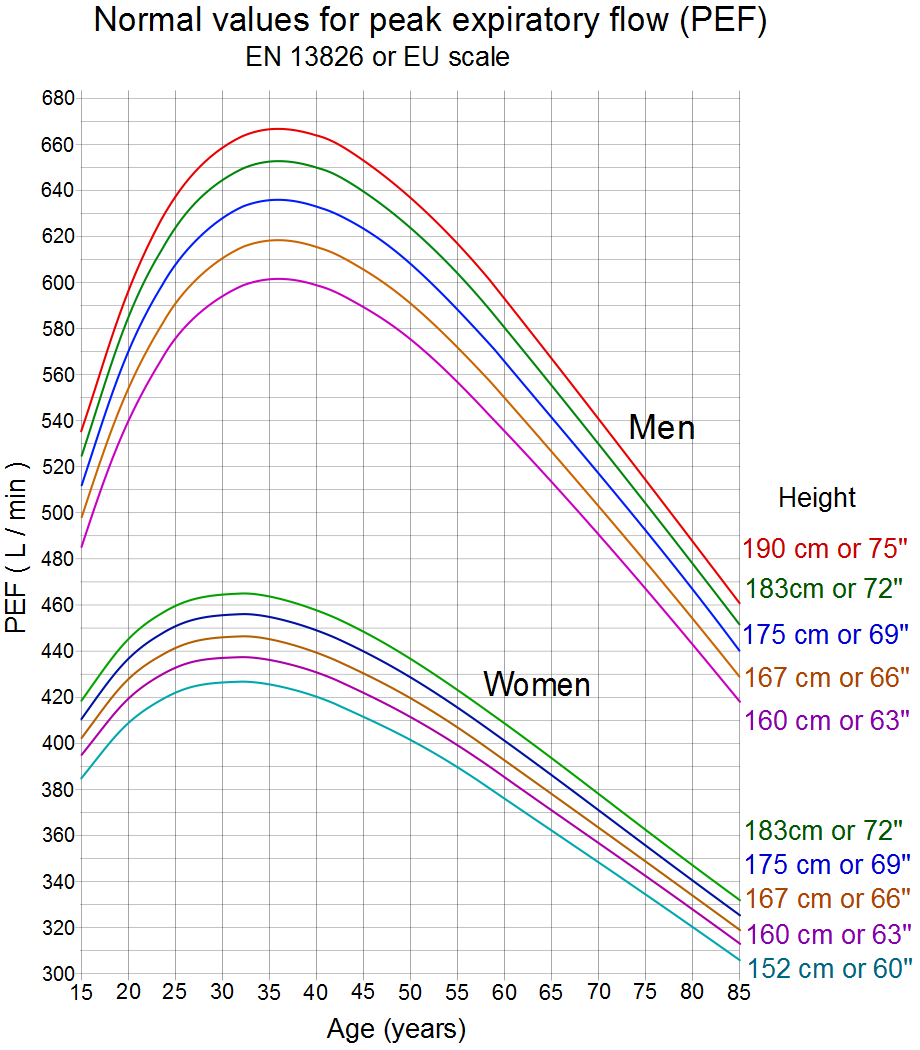
Physiology
This was previously featured in an exam
Respiratory
A patient with known COPD presents to ED with worsening breathlessness. You are looking at her old notes and noticed recent spirometry results. Which of the following findings would you expect:
Answer:
Typical Obstructive Disease Pattern:- Increased airway resistance
- FVC: Normal or low
- FEV1: Low (<0.8)
- FEV1/FVC Ratio: Low (<0.7)
- Vital capacity: Low
- Residual volume: High
- Total lung capacity: Normal or high
Expiratory Flow Rates
Physiology / Respiratory / Lung Mechanics
Last Updated: 19th April 2020
Lung volumes can be measured with spirometry. Airway resistance and lung compliance can be assessed indirectly by measuring the forced expiratory flows and volumes.
Peak Expiratory Flow Rate
The easiest and quickest measurement is the peak expiratory flow rate (PEFR). PEFR is reduced if airway resistance is increased in obstructive disease and is commonly used to monitor asthma. It is dependent on the initial lung volume and therefore on the patient's age, sex and height.

Normal Values for Peak Expiratory Flow (Example). (Image by Häggström, Mikael (2014). "Medical gallery of Mikael Häggström 2014". WikiJournal of Medicine 1 (2). DOI:10.15347/wjm/2014.008. ISSN 2002-4436. Public Domain)
Forced Vital Capacity
The forced vital capacity (FVC) is the volume of air that can forcibly be blown out after a maximum inspiration.
Forced Expiratory Volume
The forced expiratory volume in 1 second (FEV1) is the volume of air that can forcibly be blown out after maximal inspiration in one second.
This is normally expressed as a ratio to FVC to correct for lung volume.
FEV1/FVC Ratio
The FEV1/FVC ratio is usually 0.75 - 0.90.
The FEV1/FVC ratio can be used to distinguish between obstructive (increased airway resistance) and restrictive (decreased lung compliance) disease.
In obstructive disease, slowing of expiratory flow means that a low proportion of the FVC is expired in the first second and thus the FEV1/FVC ratio is reduced (normally < 0.7).
In restrictive disease, FEV1 and FVC are both reduced, but the FEV1/FVC ratio is normal or even increased due to greater elastic recoil.
| Disease | Obstructive Disease | Restrictive Disease |
|---|---|---|
| Pathophysiology | Increased airway resistance caused by narrowing of the airways | Impaired ability of the lungs to expand caused by decreased lung compliance |
| Examples | COPD, asthma, emphysema, bronchiectasis | Intrinsic causes: interstitial lung disease, pulmonary oedema, pneumonia, parenchymal lung tumours; Extrinsic causes: pleural effusion, pleural adhesions, pneumothorax, chest wall deformities, neuromuscular disease, connective tissue disease, obesity or pregnancy |
| FVC | Normal or low | Low (< 0.8) |
| FEV1 | Low (< 0.8) | Low (<0.8) |
| FEV1/FVC ratio | Low (< 0.7) | Normal or high (>0.7) |
| Vital capacity | Low | Low |
| Residual volume | High | Normal or low |
| Total lung capacity | Normal or high | Low |
Report A Problem
Is there something wrong with this question? Let us know and we’ll fix it as soon as possible.
Loading Form...
- Biochemistry
- Blood Gases
- Haematology
| Biochemistry | Normal Value |
|---|---|
| Sodium | 135 – 145 mmol/l |
| Potassium | 3.0 – 4.5 mmol/l |
| Urea | 2.5 – 7.5 mmol/l |
| Glucose | 3.5 – 5.0 mmol/l |
| Creatinine | 35 – 135 μmol/l |
| Alanine Aminotransferase (ALT) | 5 – 35 U/l |
| Gamma-glutamyl Transferase (GGT) | < 65 U/l |
| Alkaline Phosphatase (ALP) | 30 – 135 U/l |
| Aspartate Aminotransferase (AST) | < 40 U/l |
| Total Protein | 60 – 80 g/l |
| Albumin | 35 – 50 g/l |
| Globulin | 2.4 – 3.5 g/dl |
| Amylase | < 70 U/l |
| Total Bilirubin | 3 – 17 μmol/l |
| Calcium | 2.1 – 2.5 mmol/l |
| Chloride | 95 – 105 mmol/l |
| Phosphate | 0.8 – 1.4 mmol/l |
| Haematology | Normal Value |
|---|---|
| Haemoglobin | 11.5 – 16.6 g/dl |
| White Blood Cells | 4.0 – 11.0 x 109/l |
| Platelets | 150 – 450 x 109/l |
| MCV | 80 – 96 fl |
| MCHC | 32 – 36 g/dl |
| Neutrophils | 2.0 – 7.5 x 109/l |
| Lymphocytes | 1.5 – 4.0 x 109/l |
| Monocytes | 0.3 – 1.0 x 109/l |
| Eosinophils | 0.1 – 0.5 x 109/l |
| Basophils | < 0.2 x 109/l |
| Reticulocytes | < 2% |
| Haematocrit | 0.35 – 0.49 |
| Red Cell Distribution Width | 11 – 15% |
| Blood Gases | Normal Value |
|---|---|
| pH | 7.35 – 7.45 |
| pO2 | 11 – 14 kPa |
| pCO2 | 4.5 – 6.0 kPa |
| Base Excess | -2 – +2 mmol/l |
| Bicarbonate | 24 – 30 mmol/l |
| Lactate | < 2 mmol/l |

